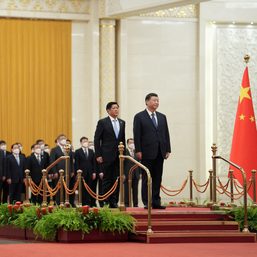SUMMARY
This is AI generated summarization, which may have errors. For context, always refer to the full article.

As the year comes to a close, I offer some reflections on strategic thinking in the Philippines or, really, the lack of it. These thoughts come to mind as we see the acceleration of China’s provocations in the West Philippine Sea, particularly in Scarborough Shoal (Bajo de Masinloc) and Second Thomas Shoal (Ayungin).
What will the Philippines do to protect these flashpoints in the long term, and how will it avert a violent confrontation with China? What creative thinking is going on about BRP Sierra Madre beyond the occasional repair of its insides?
In the years past, it’s as if our policymakers stumbled into making certain decisions, simply reacting to the gravity of events. They thought in election cycles, every six years, narrowing their fields of vision.
To refresh our memories, I will go back to two major events that shaped part of the national security policy, hoping to remind our leaders that strategic decisions have to be made now—and not when a crisis is about to unfold.
One happened in 2012, during a crisis, and the other in 2019, with a foreign investment gone awry. The first eventually strengthened the Philippine Coast Guard and thrust it into a pivotal role in the West Philippine Sea, and the other led the Navy to its long overdue home, the government making up for years of neglect. This also allowed the Navy to beef up its territorial defense in the West Philippine Sea.
One: Scarborough crisis and the Coast Guard
It was in 2012 when China and the Philippines engaged in a tense standoff over Scarborough Shoal that lasted over a month. It ended with China seizing Scarborough which is part of the Philippines’ exclusive economic zone or EEZ.
The crisis began when the Navy tried to accost Chinese fishermen poaching yet again in Scarborough. This was a routine mission for the Navy, having been deputized by the government to perform duties of the Coast Guard which, at the time, did not have enough ships.
But China did something different. For the first time, it called the world’s attention to the Philippines’ use of the Navy, sending a warship to perform a civilian law-enforcement function. It portrayed the Philippines as an aggressor.
Immediately, Manila sought to ease the tension and pulled out the BRP Gregorio del Pilar, then the crown jewel of the Navy, its fastest ship at the time. The Coast Guard jumped in and sent its ten-year-old search-and-rescue vessel, the BRP Pampanga.
This was the Coast Guard’s baptism of fire. The BRP Pampanga was unprepared. Its fresh water supply was limited and Its desalination plant was badly in need of repair or replacement. Of the four binoculars on the ship, one was borrowed, the other was unreliable, while the others had cloudy vision.
The state of BRP Pampanga showed that the government didn’t give the Coast Guard much attention despite the fact that the maritime law-enforcement demands were enormous. The Philippines, after all, is one of the top ten countries in the world with the longest coastlines.
Moreover, the Coast Guard’s role was eclipsed by the Navy which traditionally dominated sea patrol. These two services were also embroiled in a long-standing turf war. After all, the Coast Guard used to be part of the Navy. It left its mothership in 1998 but its transition to a civilian agency was not easy. Thus, even 14 years later during the Scarborough standoff, the Coast Guard was still ill-equipped.
But the standoff changed the fortunes of the Coast Guard. Then-President Benigno Aquino III started to upgrade the Coast Guard, initiating an Official Development Assistance loan from Japan for ten patrol vessels. His successor, Rodrigo Duterte, continued this. Today, Marcos is on the same track, recently approving the purchase of five more patrol vessels from Japan.
The Coast Guard has since surged to the frontlines of the West Philippine Sea, a long way from the days when it drifted on the periphery.
Two: Hanjin’s bankruptcy and the Navy’s home
It is hard to believe that, for decades, the Navy didn’t have its own base with a harbor where its frigates could dock. Through the years, their ships squatted in commercial ports like the North and South Harbors in Manila, as well as in Davao and Zamboanga.
It only dawned on me, while doing research for an upcoming book on China and the Philippines during the Duterte years, that our Navy had been homeless. Think about this: A maritime country with a Navy that borrowed berths. I had difficulty letting this fact sink in.
Having their own home wasn’t on their near-term horizon. But the bankruptcy of Hanjin shipyard in Subic in 2019 became an opportunity for the Navy. When Chinese companies showed interest in taking over the shipyard, the Navy acted immediately to foil this.
They proposed to then-Defense Secretary Delfin Lorenzana that the Navy set up its base at the 300-hectare shipyard in Subic. Lorenzana brought this up with Duterte during a command conference of the Armed Forces of the Philippines in Malacañang. Duterte then called in Carlos Dominguez, then finance secretary, to cobble a deal, together with Teodoro Locsin Jr., then foreign affairs secretary, and Babe Romualdez, ambassador to the US.
It took almost three years to negotiate an agreement with a US private equity company, Cerberus Capital Management. Finally, in May 2022, the Navy took over 90 hectares of the shipyard, leasing it from Cerberus.
The Navy’s capital ships—their most modern and the latest in their inventory—now have a berthing place, facing the West Philippine Sea.
Let me know what you think. You can email me at marites.vitug@rappler.com. – Rappler.com
Add a comment
How does this make you feel?















![[Just Saying] SONA 2024: Some disturbing points](https://www.rappler.com/tachyon/2024/07/TL-marcos-sona-points-july-23-2024.jpg?resize=257%2C257&crop=335px%2C0px%2C720px%2C720px)

There are no comments yet. Add your comment to start the conversation.